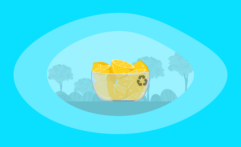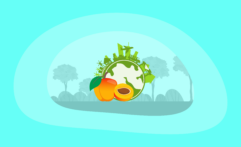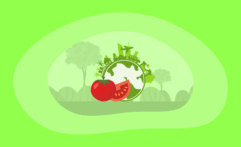The Environmental Impact of Bananas: From Farm to Table
Impactful Ninja is reader-supported. When you buy through links on our site, we may earn an affiliate commission.
Learn more
Learn more
.
Hey fellow impactful ninja ? You may have noticed that Impactful Ninja is all about providing helpful information to make a positive impact on the world and society. And that we love to link back to where we found all the information for each of our posts. Most of these links are informational-based for you to check out their primary sources with one click. But some of these links are so-called "affiliate links" to products that we recommend. First and foremost, because we believe that they add value to you. For example, when we wrote a post about the environmental impact of long showers, we came across an EPA recommendation to use WaterSense showerheads. So we linked to where you can find them. Or, for many of our posts, we also link to our favorite books on that topic so that you can get a much more holistic overview than one single blog post could provide. And when there is an affiliate program for these products, we sign up for it. For example, as Amazon Associates, we earn from qualifying purchases. First, and most importantly, we still only recommend products that we believe add value for you. When you buy something through one of our affiliate links, we may earn a small commission - but at no additional costs to you. And when you buy something through a link that is not an affiliate link, we won’t receive any commission but we’ll still be happy to have helped you. When we find products that we believe add value to you and the seller has an affiliate program, we sign up for it. When you buy something through one of our affiliate links, we may earn a small commission (at no extra costs to you). And at this point in time, all money is reinvested in sharing the most helpful content with you. This includes all operating costs for running this site and the content creation itself. You may have noticed by the way Impactful Ninja is operated that money is not the driving factor behind it. It is a passion project of mine and I love to share helpful information with you to make a positive impact on the world and society. However, it's a project in that I invest a lot of time and also quite some money. Eventually, my dream is to one day turn this passion project into my full-time job and provide even more helpful information. But that's still a long time to go. Stay impactful,Affiliate Disclosure
Why do we add these product links?
What do these affiliate links mean for you?
What do these affiliate links mean for us?
What does this mean for me personally?
![]()
Bananas are a very popular fruit, with over 100 billion consumed every year, especially considering their wide culinary uses, from banana bread to milkshakes. They also have some notable health benefits. They’re high in fiber, protein, and potassium. But all this can come at a high price to the environment. Many aspects of banana farming and distribution can negatively impact the environment. So we had to ask: What is the environmental impact of bananas?
Bananas have a moderately negative impact on the environment. They use a significant amount of pesticides, grow in monocultures, and contribute to landfills through plastic and organic waste. However, they also require minimal irrigation and have economical land usage.
In this article, we will examine the environmental impact of bananas from several different angles. We will go through the life-cycle of bananas, detailing its impact on the environment from growth to distribution to your plate and waste management. We will then compare the environmental impact of bananas to that of other fruits. And, finally, we’ll share some tips with you on how you can reduce your own environmental impact and offset your own carbon emissions – both for your personal life and banana-related.
Here’s How We Assessed the Environmental Impact of Bananas
The Environmental Impact Assessment (EIA) is one of the ways we measure the potential environmental effects of our actions, like the consumption of bananas. It is a holistic assessment based on the environmental changes associated with our consumption. These are changes in our environment that can have adverse effects on the air, land, water, fish, and wildlife or the inhabitants of the ecosystem.
“Environmental Impact: the effect that the activities of people and businesses have on the environment”
Cambridge Dictionary
All goods and services you buy – including bananas – leave an impact on our environment. When it comes to food in general, and bananas specifically, the following are key factors:
- Land requirements: Large parts of the world that were once covered by forests and wildlands are now used for agriculture. 10 million hectares of forest are destroyed annually and 50% of the world’s habitable land is now used for agriculture. This loss of natural habitat has been the main driver for reducing the world’s biodiversity.
- Water footprint: 70% of global freshwater is now used for agricultural purposes. By assessing the water footprint of a particular food, we can determine how our limited freshwater resources are being consumed and polluted.
- Pesticide and fertilizer usage: Pesticides and fertilizers provide a range of agricultural benefits. However, numerous studies link pesticides and fertilizers to serious effects on human health, along with disruptions to vital ecosystems and the spread of aquatic dead zones.
- Carbon footprint: The carbon footprint is one of the ways we measure the effects of our human-induced global climate change. Today, food production accounts for over a quarter (26%) of global greenhouse gas emissions.
- Waste generation: Food and its packaging account for almost 45% of the materials landfilled in the US alone. And packaging sent to landfills, especially when made from plastics, does not degrade quickly or, in some cases, at all.
To understand the overall environmental impact of bananas, we must assess each of their key factors. The Environmental Impact Assessment (EIA) is a tool originally developed to identify the environmental impacts of a project prior to decision-making and also helps us to evaluate the environmental impacts of bananas, from farm to table.
Here’s the Overall Environmental Impact of Bananas
The environmental impact of bananas is moderately negative. The most prominent factors are their packaging and food waste, pesticide use, and monoculture farming. Their environmental impact is fairly average among fruits.
There are many things that bananas have going for them in terms of their environmental impact. For example, they have very economic land yields, quick growth times, and require minimal irrigation. However, there are still several factors that negatively impact the environment.
So, let’s have a look at the environmental impact of each key factor of bananas!
| Key Assessment Factors | Environmental Impact |
| Land requirements for bananas | Bananas’ land requirements are minimal. They take up little space per fruit, sequester carbon effectively, and grow very fast. Though, they still have a negative impact through their use of monocultures. Furthermore, high demand for bananas has caused significant deforestation, particularly in Costa Rica. |
| Water footprint of bananas | Bananas have a water footprint of about 50–75 inches of water per year. They require minimal irrigation, but need a significant amount of water to clean up their high pesticide residues. These pesticides can also seep into natural water sources, potentially harming local wildlife. |
| Agrochemical usage for bananas | Bananas’ heavy use of pesticides and fertilizers has a fairly negative impact on the environment. This is because they use a higher-than-average amount of pesticides and nitrogen fertilizers. |
| Carbon footprint of bananas | Bananas have a moderate carbon footprint of 0.21 kg (0.48 lb) of CO2e per pound of bananas. The main factors that contribute to these emissions are transportation fuel, pesticides, and plastic waste. They have a relatively high carbon footprint compared to many other fruits. |
| Waste generation of bananas | The waste generation of bananas is significant. They produce a significant amount of organic waste and plastic waste. Both of these types of waste mainly go to landfills, meaning they have a very negative environmental impact. |
These are the overall summaries, but there is a lot more to the story. In the next few sections, we will dive deeper into each stage to illustrate all the important aspects of bananas’ environmental impact.
What Are the Land Requirements for Bananas
Bananas’ land requirements are minimal. They take up little space per fruit, sequester carbon effectively, and grow very fast. Though, they still have a negative impact through their use of monocultures. Furthermore, high demand for bananas has caused significant deforestation, particularly in Costa Rica.
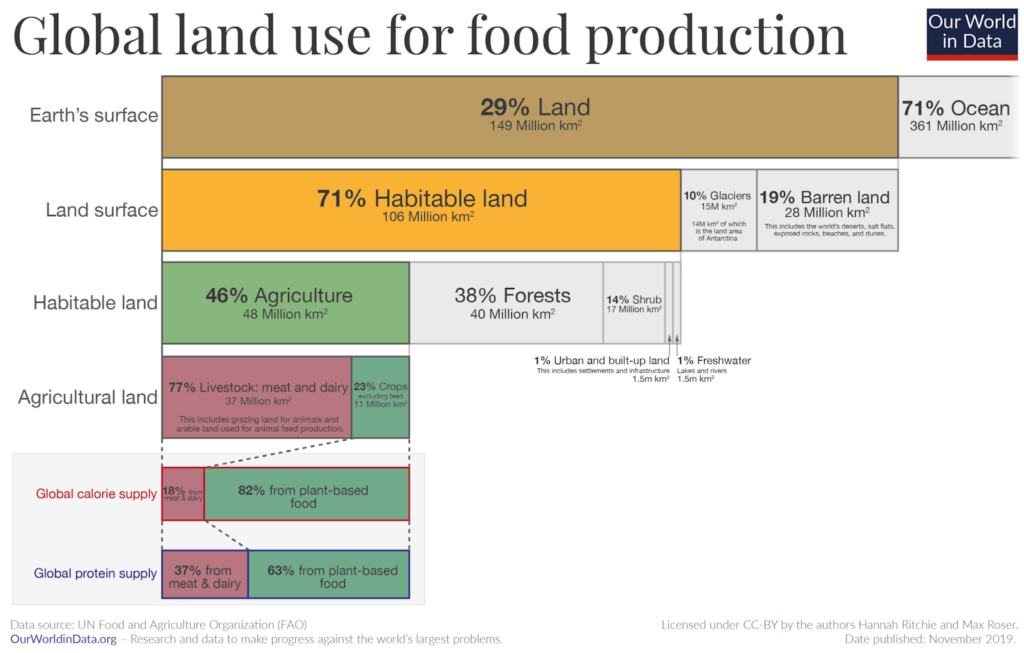
Growing bananas has a lot of variables that contribute to their environmental impact. The amount of land they use, the way in which they grow (tree, vine, root, etc.), and their specific farming practices will all contribute to their environmental impact.
How do the land requirements of bananas impact their environmental footprint?
- What is the land usage of bananas: Banana farms can yield very high quantities, up to 100 tons per hectare. This is one of the highest yields amongst fruits. For example, watermelons only yield around 2–3 tons per hectare. This means that each banana has a lower square foot requirement than other fruits. However, due to the extreme demand for bananas, they actually still cause significant deforestation, especially in the Costa Rican rainforest, to construct farms. So despite their economical yield, their land usage still causes significant environmental destruction.
- Where and how are bananas grown: Bananas grow on banana bushes. These bushes have natural carbon sequestration properties. This means that some of their carbon emissions are offset by their ability to store carbon in the ground. US-consumed bananas are mainly grown in Guatemala, which has a mountainous geography. Unfortunately, however, bananas are also grown in monoculture formations. Monocultures lack biodiversity and thus are bad for wildlife and soil microbes. So, though banana bushes can sequester carbon, growing them in monocultures means that this stage has a negative impact on the environment.
- How does the banana industry affect the loss of habitable land: Bananas are mainly grown in Guatemala, but many are also grown in South America. Bananas have been named as a significant contributor to rainforest destruction. The Amazon has been home to indigenous peoples for millennia, many of whom have filed lawsuits against agricultural corporations for destruction of their lands. As of 2017, banana farming takes up 5.6 million hectares of land.
- How does the banana industry affect wildlife and biodiversity: Monoculture farming in the banana industry harms wildlife significantly due to biodiversity loss. Deforestation also has a devastating effect on wildlife. For example, Costa Rica holds 5% of the world’s biodiversity. In 1992, the Province of Limon lost 166,460 hectares of forest which displaced numerous species such as monkeys, sloths, and various bird species.
In short, bananas’ land requirements have a negative effect on their environmental impact. They are extremely land efficient, have carbon-sequestering properties, and have a short growth turnaround. However, their monoculture growth practices and the significant expansion of the industry has led to mass rainforest destruction and biodiversity loss.
What Is the Water Footprint of Bananas
Bananas have a water footprint of about 50–75 inches of water per year. They require minimal irrigation, but need a significant amount of water to clean up their high pesticide residues. These pesticides can also seep into natural water sources, potentially harming local wildlife.
Water usage is one of the most important factors in the environmental impact of a fruit. The amount of water used, as well as the way they affect the water sources around them, are all major contributing factors. Here, we will look at these different angles to bananas’ water impact.
How does the water footprint of bananas impact their environmental footprint?
- What is the overall water usage of bananas: Bananas require about 50–75 inches of water per year, equivalent to around 52 gallons of water per year. This is on the moderate side of water usage for a fruit, with other fruits such as citrus having significantly higher water usage.
- What is the green water footprint of bananas: The green water footprint is the amount of water from precipitation stored in the soil and used by plants for growth. Most bananas consumed in the US are grown in Guatemala. Guatemala gets around 50 inches of rain per year. This covers the lower end of bananas’ water needs, which are 50–75 inches of rain per year. Thus, natural sources account for the majority of bananas’ water needs, so their green water footprint doesn’t have a significantly negative impact on the environment.
- What is the blue water footprint of bananas: The blue water footprint is the amount of water sourced from surface (such as rivers or lakes) or groundwater resources. Bananas may require some additional water outside of the 50 inches of rain per year in Guatemala to cover their 50–75 inch per year requirement. Thus, there may be some additional irrigation required. Irrigation has a negative environmental impact, due mainly to its high carbon footprint and modification of groundwater balance.
- What is the gray water footprint of bananas: The gray water footprint is the amount of freshwater required to clean up water pollution to meet certain quality standards. Essentially, it’s the amount of water needed to make polluted water clean enough to be safe and healthy for humans and the environment. Bananas use higher than average pesticides. Pesticides pollute the groundwater, meaning excess water is required to clean them up. Because of their heavy pesticide use, bananas have a significantly negative gray water footprint.
- How does the banana industry affect freshwater and ocean pollution: Bananas’ high pesticide usage is very detrimental to water sources. Pesticide pollution can easily get into freshwater sources, where it causes a great deal of harm to marine life. For example, spectacled caimans in Costa Rican rivers have been found with traces of 9 pesticides in their blood, 7 of which have been banned for use since 2011. Results of this study showed that caimans close to banana plantations were consistently in much poorer health than those further upstream.
In short, the water footprint of bananas is moderately negative. Though they don’t require too much irrigation, they do require a lot of water to clean up their high pesticide pollution. Furthermore, there is evidence that heavy pesticide use is impacting local wildlife populations.
What Is the Agrochemical Usage for Bananas
Bananas’ use of pesticides and fertilizers has a fairly negative impact on the environment. This is because they use a higher-than-average amount of pesticides and nitrogen fertilizers.
Pesticides and fertilizers can have a significant impact on the environment. They both require resources to create as well as have detrimental effects on the life around them. Here, we will look at how bananas’ pesticide and fertilizer rates affect their environmental impact.
How does the pesticide and fertilizer usage of bananas impact their environmental footprint?
- What is the pesticide usage of bananas: Bananas use a high amount of pesticides. Pesticides have a negative impact on the environment because they pollute groundwater, have a high carbon footprint, and can even harm wildlife.
- What is the fertilizer usage of bananas: The main fertilizer that bananas use is potassium. Potassium generally has minimal negative impact on the environment. They also use phosphorus, nitrogen, and magnesium. Nitrogen has a significantly negative environmental impact. Overall, their lower use of nitrogen compared to potassium means their fertilizer use has a moderately negative environmental impact.
- Are there any known issues connected to the agrochemical usage for bananas: According to a 2015 report, bananas have the highest agrochemical usage rates of any other food. According to the same study, the World Health Organization has deemed many of these agrochemicals particularly hazardous.
In short, the significant use of pesticides and moderate use of nitrogen fertilizer means that bananas’ environmental impact at this stage is fairly negative.
What Is the Carbon Footprint of Bananas
Bananas have a moderate carbon footprint of 0.21 kg (0.48 lb) of CO2e per pound of bananas. The main factors that contribute to these emissions are transportation fuel, pesticides, and plastic waste. They have a relatively high carbon footprint compared to many other fruits.
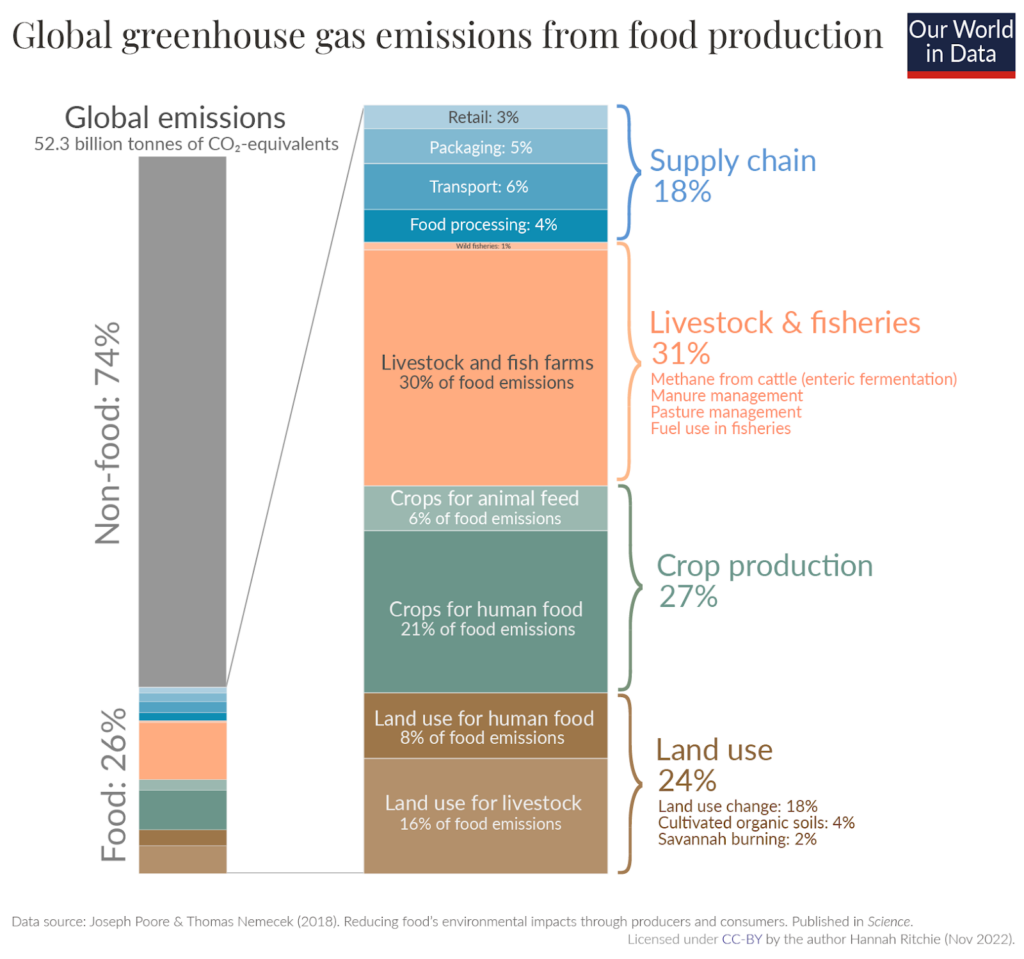
Carbon footprint is one aspect of the overall environmental impact of a fruit. It essentially measures how much carbon or other greenhouse gasses the production of bananas emits into the atmosphere. Emissions from product manufacturing, irrigation, transportation fuel, and landfills all add up to create the overall carbon footprint of a fruit. Let’s see how the carbon footprint of bananas breaks down and contributes to their environmental impact.
How does the carbon footprint of bananas impact their environmental footprint?
- What is the overall carbon footprint of bananas: The overall carbon footprint of bananas is 0.21 kg (0.48 lb) of CO2e per pound of bananas. This means that for every pound of bananas produced, 0.21kg of carbon is released into the atmosphere. This is a below-average carbon footprint among fruits.
- What are the main contributors to the carbon footprint of bananas: The main contributing factors to bananas’ carbon footprint are their use of plastic packaging, high pesticide use, and high transportation distances in refrigerated trucks.
- Which life-cycle stage of bananas has the highest carbon footprint: The end-of-life stage of bananas’ life cycle has the highest carbon footprint. This is because bananas use plastic packaging, which has a low recycling rate, and have low composting rates for their food waste.
In short, several factors, such as packaging and pesticides, contribute to the carbon footprint of bananas.
Related: Check out our full article on “What Is the Carbon Footprint of Bananas? A Life-Cycle Analysis” to find out all about the carbon footprint of bananas and how each stage of their life-cycle contributes to it (plus, what you can do to reduce your carbon footprint when shopping for bananas).
What Is the Waste Generation of Bananas
The waste generation of bananas is significant. They produce a large amount of organic waste and plastic waste. Both of these types of waste mainly go to landfills, meaning they have a very negative environmental impact.
When fruit waste, either packaging or organic materials, is disposed of, they can have a major impact on the environment. Whether it’s damaging wildlife, seeping into oceans, emitting methane, or dissolving into microplastics that contaminate groundwater, all these materials have their part to play. In this section, we will look at how banana waste affects the environment.
How does the waste generation of bananas impact their environmental footprint?
- What is the packaging of bananas: Bananas are packed in cardboard cartons with plastic covering. Plastic has devastating consequences on the environment, such as affecting ocean life, emitting greenhouse gasses in its creation, and creating toxic microplastics that get into groundwater and food. Cardboard, though better than plastic, still contributes to deforestation which also has a negative environmental impact.
- How is the packaging of bananas disposed of: Plastic and cardboard can both be recycled, but they have very different recycling rates. Plastic has a low recycling rate of around 9%, whereas cardboard has a high recycling rate of around 89%. Because of the low recycling rates, the plastic component of banana packaging tends to end up in landfills. Landfills are terrible for the environment. They emit carbon, pollute the soil, and harm wildlife. Because so much banana packaging ends up in landfills, this stage has a very negative environmental impact.
- How are bananas disposed of: Bananas have peels that can theoretically be composted. However, food in general has a very low composting rate of around 4%. This means that the majority of banana waste ends up in landfills. Landfills are very harmful to the environment. They generate the greenhouse gas methane with food waste. On top of the peels from the 100 billion bananas consumed every year globally, Americans are estimated to throw away 5 billion full bananas annually. Thus, bananas contribute significantly to landfills and have a negative environmental impact at this stage.
In short, the types of packaging used—mainly plastic—as well as the organic waste from bananas frequently end up in landfills, negatively impacting the environment significantly.
What Have Been Historical Environmental Issues Connected to the Banana Industry
Bananas have partaken in several farming practices that have harmed the environment significantly over the years. These include destruction of the Amazon, damage to aquatic life from pesticides, and disruption of water balance.
All fruits have had a complex road toward global distribution. They originate in one part of the world and often travel far to end up in your local supermarket. From farm to table, some of our favorite fruits have racked up some serious environmental damage along the way. Whether it’s deforestation to meet demand, water pollution, or disruption of wildlife, most fruits have left a path of destruction. Let’s see how bananas have fared throughout history.
What have been the key historical environmental issues of the banana industry?
- How much land has been lost because of banana production: Land devoted to banana use has gone up considerably over the years. Between 1993 and 2017, bananas’ global land use increased by 2 million hectares from 3.6 million to 5.6 million. India and China in particular increased their banana production by 48% and 83%, respectively, between 2000 and 2015. All of these expansions have encroached considerably on wildlands over the last few decades.
- Which wildlife species have been negatively impacted or displaced because of banana production: Many animal and insect species native to the Amazon rainforest have been affected by the banana industry’s deforestation. Since 1998, humans have been destroying an average of 4,000 hectares of rainforest every day, in part due to agricultural lands for products like bananas. Every hectare of rainforest contains over 40,000 insect species, as well as hundreds of trees, plants, and animals. This means that the 4,000 hectares destroyed every day are eliminating habitats for millions of plants and animals. Aquatic life has also been seriously harmed by their extremely high agrichemical use.
- Have water sources and soil been contaminated because of banana production: Bananas’ use of agrichemicals has had a severe effect on water sources. Pesticide and fertilizer can easily end up in freshwater sources, which harms humans and wildlife alike. Bananas’ water usage has also led to excessive draining of water resources in nearby areas, which has permanently damaged the environment and caused droughts.
In short, bananas have had a severe impact on the environment over the years. From causing severe deforestation to contaminating water sources, the environment has endured a lot from the banana industry over the years.
What Is the Overall Environmental Impact of Food and Agriculture
Food production in general has a high environmental impact. Everything from the amount of land used to the energy involved in irrigation to its effect on plant and animal biodiversity can be a factor in this. In the chart below, you can see how food production is one of the biggest influences on these areas of the environment.
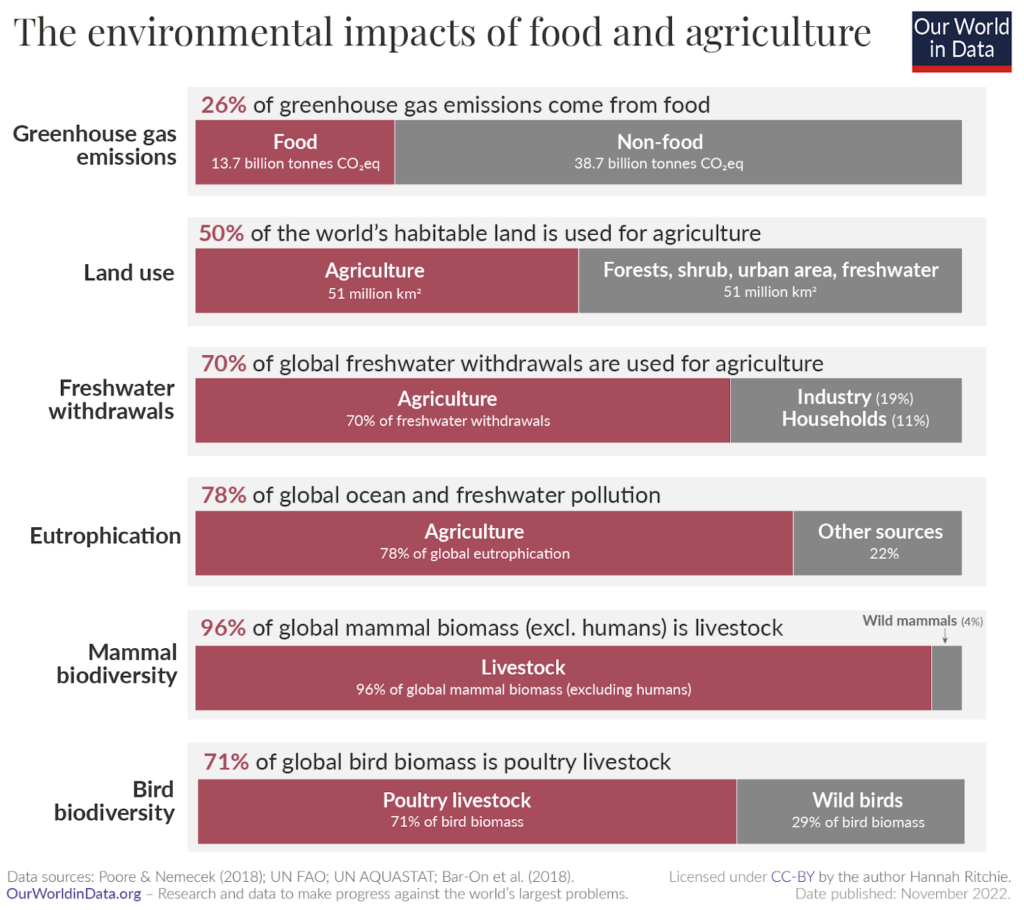
Agriculture alone accounts for over a quarter of global greenhouse gas emissions, while using half of the world’s habitable land and 70% of the global freshwater withdrawals. Agriculture also causes 78% of the global ocean and freshwater pollution.
Livestock accounts for the vast majority of non-human mammal and bird biomass. Mammal livestock outweighs wild mammals by a factor of 15-to-1, and poultry livestock outweighs wild birds by a factor of more than 3-to-1.
These statistics highlight the need for sustainable and responsible practices in food production to reduce its impact on the environment. And the need for us to shift toward more environmentally-friendly foods.
How Can You Reduce Your Environmental Impact and Offset Your Personal Carbon Footprint
There are a few things you can do to mitigate some of the negative environmental effects of consuming bananas, while still enjoying them. You can also consider offsetting your personal and banana-related carbon emissions, which work to remove carbon emissions elsewhere that are then attributed to you. Here, we will walk you through how to accomplish both of these things.
How Can You Reduce Your Environmental Impact When Shopping for Bananas
In this section, we give you a short list of ways you can reduce the negative environmental effects of bananas, based on those parts of the life-cycle of bananas that would otherwise most negatively impact the environment:
- Buy organic bananas: Pesticides contribute heavily to the negative environmental impacts of bananas. Organic farms don’t use chemicals like pesticides and so your impact will be lower if you choose organic bananas.
- Compost and recycle: Landfills are another major contributor to the environmental impact of bananas. Try to recycle as much of the packaging and compost as much of the organic waste of bananas as you can. This way, you will be contributing far less to landfills and thereby lessening your environmental impact.
- Use bananas before they go bad: With 5 billion whole bananas wasted every year, it is imperative that banana consumers try to waste as little as possible. Try to consume your bananas as soon as you can after buying them so they don’t go bad. If they are too brown to eat, consider turning them into banana bread to keep them from landfills.
- Reuse banana peels: Instead of throwing them away, use your banana peels as natural aphid deterrents or even to remove scratches from CD’s and DVD’s!
Following some of these methods can really help you to cut down on your environmental impact of eating bananas. None of these will completely eradicate these negative impacts, since there are always effects that may be outside of your control. But reduction is always better than nothing!
Which Organizations Can You Support to Help Alleviate Your Environmental Impact
Charities around the world are now waking up to the climate crisis and the rapid decline of biodiversity on our planet. Banana plantations are present in some of the world’s most significant and species-diverse rainforests around the world. So, what better way to offset the impact of consuming bananas than by donating to charities that are dedicated to protecting the wildlands and vulnerable species that surround them?
Here are some of the best environmental charities that work in the areas where banana production has affected biodiversity:
- Rainforest Trust: Founded in 1988, the Rainforest Trust works to create protected reserves in some of the most vital and vulnerable rainforests around the world, including the Amazon.
- Re:Wild: Relaunched in 2021, after three decades as the Global Wildlife Conservation Organization, Re:wild restores vital land in some of the world’s key biodiversity areas, including Costa Rica.
- The Nature Conservancy: Founded in 1951, the Nature Conservancy uses innovative conservation science techniques to solve the issue of biodiversity loss and protect our natural planet.
- Feeding America: Founded in 1979, Feeding America fights to reduce food waste, including bananas, by running food banks across America.
How Can You Offset Your Personal Carbon Footprint
The carbon footprint is a key part of your environmental impact. And it is one of the ways we measure the effects of our human-induced global climate change. Yes, even from eating bananas!
“Carbon footprint: the amount of greenhouse gasses and specifically carbon dioxide emitted by something (such as a person’s activities or a product’s manufacture and transport) during a given period”
Merriam Webster
Basically, it is the amount of carbon emitted by you as an individual or an organization providing you with goods and services – including bananas:
- This includes GHG emissions from producing the products that we use and foods that we eat (e.g., power plants, factories or farms, and landfills)
- GHG emissions from fuel that we burn directly or indirectly (e.g., logistics and transportation, cooling or heating facilities),
- as well as the GHG emissions attributed to how we consume these products and foods.
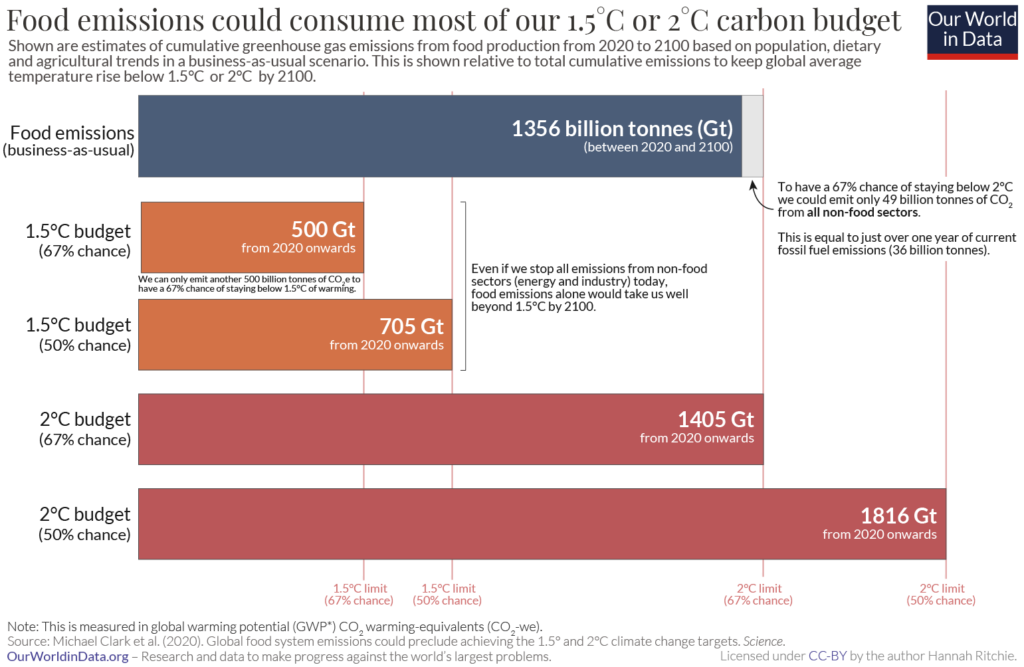
Carbon offsets are reductions in carbon emissions that are used to compensate for carbon emissions occurring elsewhere – for example for the carbon emissions that are associated with bananas. They are measured in tons of CO2 equivalents and are bought and sold through international brokers, online retailers, and trading platforms on what is known as the global carbon offset market.
“Carbon Offset: a way for a company or person to reduce the level of carbon dioxide for which they are responsible by paying money to a company that works to reduce the total amount produced in the world, for example by planting trees”
Oxford Dictionary
In terms of bananas – and indeed all food types – there will always be a carbon footprint, because of the resources it takes to get your food from farms to the place where you’ll eventually eat them. And while there are ways to reduce your carbon footprint when shopping for bananas, carbon offsets would be a way to reduce your CO2e emissions all the way down to net zero (or even to become climate positive).
However, when you purchase carbon offsets, it’s important that they actually make a difference in offsetting (aka reducing) total carbon emissions. To achieve that, the following are key criteria:
- Carbon offset projects have to be effective (different projects have different effectiveness rates)
- Carbon offset projects have to be additional
- Carbon offset projects have to be permanent
- The claims from carbon offset projects have to be verifiable
To find the best carbon offsets for you personally, check out our full guide on the best carbon offsets for individuals, where you’ll also learn more about how these carbon offset projects work, what their respective offsetting costs are, and what your best way would be to offset your own carbon emissions.
Final Thoughts
Bananas may be one of the most popular fruits, but that doesn’t stop them having a negative environmental impact. Their use of monoculture farming, excessive pesticides, and plastic packaging mean that their production harms the environment. However, they are also much more moderate with their high land yields and minimal irrigation. Therefore, their impact is only moderately negative. Through organic shopping and waste mitigation, you can help to reduce this negative impact.
Stay impactful,

Sources
- FAO: Banana Facts and Figures
- Harvard: Banana Nutrition
- Simply Recipes: Banana Bread
- Allrecipes: Quick Banana Milkshake
- Liquor.com: Banana Daiquiri
- UN Environment Programme: Environmental Impact Assessment and Strategic Environmental Assessment: Towards an Integrated Approach
- Our World in Data: The environmental impacts of food and agriculture
- Our World in Data: Global land use for food production
- World Health Organization: Preventing disease through healthy environments: a global assessment of the burden of disease from environmental risks
- ScienceDirect (Biological Conservation): Worldwide decline of the entomofauna: A review of its drivers
- EPA: The Sources and Solutions: Agriculture
- EPA: Reducing Food Waste and Packaging
- FoodPrint: The Environmental Impact of Food Packaging
- Impactful Ninja: What is the Carbon Footprint of Bananas
- Our World in Data: Global greenhouse gas emissions from food production
- Linkedin: Profitable Banana Farming
- Impactful Ninja: What is the Carbon Footprint of Watermelons
- Bananalink: All About Bananas
- Scientific.net: Carbon Storage and Sequestration of Bananas
- World Atlas: Where Do Americans’ Bananas Come From
- Country Reports: Guatemala
- Bananageddon: The Science of Bananas
- EOS: Monoculture Farming Explained
- Rainforest Alliance: Bananas From Brunch to Breakfast
- Rainforest Concern: Why Are Rainforests Being Destroyed
- Reuters: Indigenous Amazonians Sue Retailer
- Ecologi: How Does Deforestation Impact Wildlife and Biodiversity
- Rainforest Alliance: Bananas
- Happy Sprout: When Do Banana Trees Produce Fruit?
- Home Guides: Banana Plants and Irrigation
- Eco Family Life: How Much Water Does a Banana Tree Need?
- Arizona: Irrigating Citrus Trees
- Water Footprint: What is a Water Footprint?
- World Atlas: Where Do America’s Bananas Come From?
- Climates to Travel: Guatemala
- Science Direct: Energy and Carbon Footprint of Irrigation
- World Atlas: What is the Environmental Impact of Irrigation?
- Greyhound Chrom: Why Do Bananas Require So Many Pesticides?
- USGS: Pesticides in Groundwater
- Science Direct: Towards Understanding the Impact of Pesticides on Freshwater
- IUCN: Marine Plastic Pollution
- Pesticide.org: Pesticides and the Climate Crisis
- GOV.BC: Environmental Protection and Pesticides
- Home for the Harvest: How to Fertilize Banana Trees
- Plant Nutrition: Potassium
- Mitsui: Reducing the Environmental Impact of Chemical Fertilizers
- Bananalink: The Problem With Bananas
- The Guardian: What is the Carbon Footprint of a Banana
- Agric: Harvesting, Packing, and Storing Bananas
- St Mary Gillingham: Journey of Bananas
- Also Known As: 12 Interesting Facts About Packaging Waste
- EPA: Reducing the Impact of Waste Food
- Biological Diversity: The Plastic-Production Problem
- Teorra: What is the Carbon Footprint of Packaging
- UNEP: Plastic Planet
- TRVST: Environmental Impact of Cardboard
- SL Recycling Ltd: What Are the Negative Effects of Landfill
- GOV.BC: Waste Management
- Chicago Tribune: 5 Million Bananas Get Thrown Away Each Year
- Rainforest Alliance: Banana
- Sentient Media: Amazon Deforestation
- NPS: Wildlife of the Tropical Rainforests
- FAO: Water Footprint of the Banana
- Our World in Data: The environmental impacts of food and agriculture
- Our World in Data: Emissions from food alone would take us past 1.5°C or 2°C this century
- Impactful Ninja: Why Is a Carbon Footprint Bad for the Environment
- Impactful Ninja: Best Carbon Offsets for Individuals
